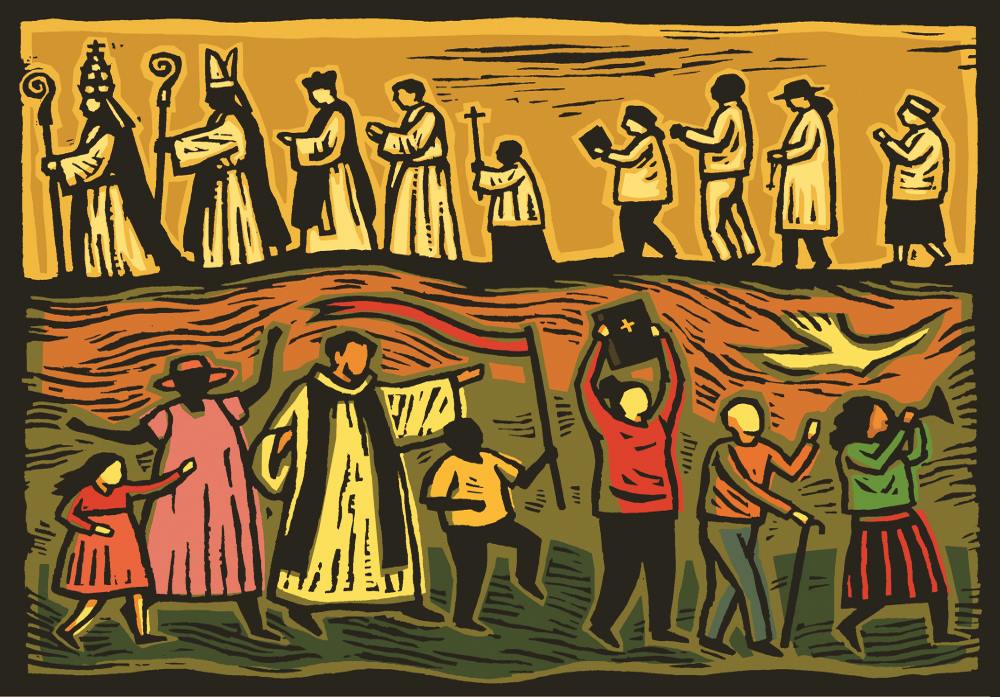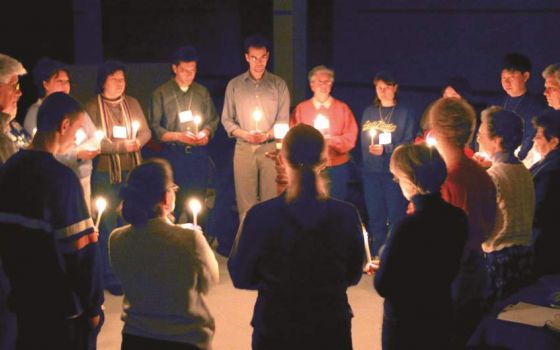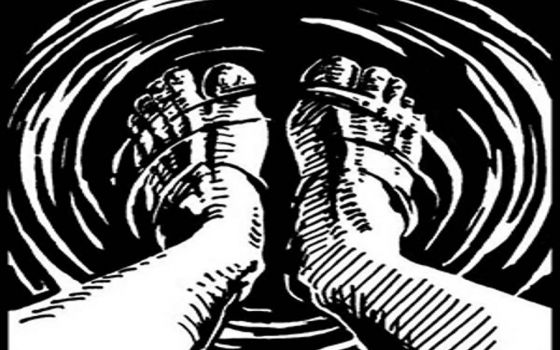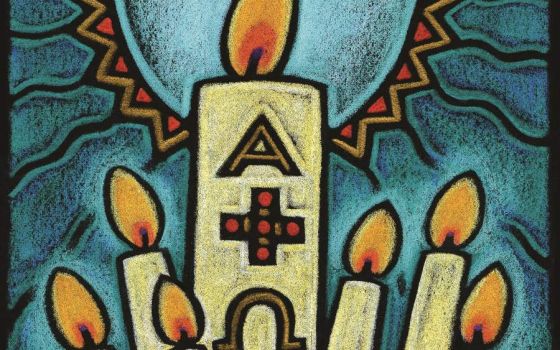
Art by Julie Lonneman
Feasting, then fasting for the feast
Lent has always been a tough subject and season for me to embrace. I suppose it was meant to be. And, if we are serious about it and looking for transformation (nothing casual about that!) then it is interesting that cultures everywhere have pulled up its antidote or opposite to precede our serious buckling down to Lent. We call it: Carnival, Fasching, Mardi Gras, Shrove Tuesday, Shrovetide, Pancake Fest, even Bacchanal. Carnival means farewell to flesh/meat. Fasching is Southern German or Austrian and it refers only to the days that precede Lent. Mardi Gras, French for Fat Tuesday or Shrove Tuesday, is the season when we confess our sins and are absolved or “shriven" from our sins. Pancake Fest — is when the British eat, at least in the U.S., those dry leather flaps which were fried in a pan and end up better used in a relay race where many flap to the floor. The carnival pancakes are really yeast dough balls, fried in Mardi Gras' fat, sometimes injected with jelly and rolled in sugar or yeast dough enhanced with dry fruits and slipped into a pan of hot fat to cook to a golden brown. Now that's a proper pancake.
Though most notably observed in New Orleans, Mardi Gras is also celebrated in St. Louis, Missouri, and Mobile, Alabama (where it first began on this continent). French European customs still linger in those celebrations, with a kings' cake from Epiphany-tide and costumes. But we, as a culture of our own, are prone more to imitate the beads and dress-up, than to burrow into the deeper meanings of this season and how it is meant to launch us into something deadly serious. Family customs and parish celebrations might take a creative look at what their own regional gifts and customs might incorporate. What is the archetypal root of this season? How can we make a community celebration that pre-figures where we are going next?
It's good to remember that carnival was a kind of dumping out of all our figuratively messy drawers and making a grand upheaval, only to spend the next five weeks, sorting, reducing, pitching, cleaning and ordering — outward signs of inward considerations.
Dressing up in costumes could be a serious exercise in communicating with our own dark side, our shadow, which we have a great tendency to project on others rather than grapple with and embrace as our own. One need only consider those dream images that the unconscious coughs up that scare us to death, irritate us, disgust or (and here's the rub) even delight us, dazzle us, or seem so wonderful as to be out of our reach. Our shadow figure is that part of ourselves which we have refused to accept as part of ourselves. Otherwise, she wouldn't have such a visceral effect on us. Think of the lady on your committee who bugs you to pieces. You have a gut feeling full of dislike for her. She just isn't a bit like you in any way and you reject her personality, her values, the way she dresses, her attitudes, her habits — gotcha! She's your shadow! Dress up like one of those ladies and take yourself to the carnival. Where does the virulent racism, sexism, every sort of ism come from but from ourselves? We are what we hate and we hold ourselves distant from that reality. People of color — of another economic tear — of another part of the world — with another language. That is our shadow and how we see and treat these people says everything about ourselves.
We are what we admire from a distance. Think of that lovely man, Gandhi. In your dream, you found him sitting in your basement and he was sorting potatoes. What? Sir! Come away from those dusty potatoes and let me bring you upstairs and make you some tea! Is this Gandhi a soulmate you have relegated to the basement of your unconscious to sort through the roots of deep meaning which you have forgotten in some dark place? Carnival dares you to dress like Gandhi and take that part of yourself seriously.
One priest I knew, both fussy and obsessive compulsive, dressed as an unshaven bagman. Really, it almost killed him, he was so uncomfortable. He vowed to embrace and learn to love what was messy in poverty and disorder and do something about it. A child, always burrowing in the cupboards looking for goodies, dressed herself as a nibbling mouse and was not going to eat between meals during Lent. A woman who recognized how she neurotically needed to control everything and everyone but had never consciously realized that before, dressed as a queen. A rather introverted and quiet young man came as a brazen cowboy with two toy guns strapped to his belt. He vowed he was going to speak up for principles, spread his shoulders and take responsibility for what matters.
In times past and in agrarian cultures, after the feasts of Christmas and Epiphany, the winter stores were seriously getting thin. The chickens were not laying in the dark and cold, people were scraping the bottom of the fat barrels and butter crocks. Grain bins were getting low. Hams and sausages were getting scarce. So fasting was upon us, willy-nilly. Why not scrape it all together, eat most of it up. Call for a "Fast with Meaning." And, look into the new chores of spring, a time when we clean up and start anew, both on the outside, but also in the inner world of the spirit.
Let the carnival begin
Parish or family carnival celebrations can have us feast on the foods we won't eat during Lent, games that pull us out of ourselves and have us laughing and interchanging with a community that blossoms when it plays and shares. You can learn to make masks at the party or hats out of paper bags.
On a long table, the word that we will not say or sing for five weeks, "ALLELUIA," is written beautifully on a long scroll, and during the evening, all are invited to illuminate and decorate this amazing word of joy and release. At the end of the evening, the group can carry that banner outside, singing every Alleluia they can possibly sing. We halt outside before a brazier and became silent. A small boy, on his granddad's arm, loudly whispers: "Grampa! Grampa, sing Happyluia some more!" But with that, we roll up and bury that fine exclamation in a chest, or in the church columbarium, until its resurrection at the Easter Vigil. It's an ancient custom, this burial.
In the brazier, we put our palms of last year — we might add our masks or some part of our dress-ups, or a written bad habit we would like to work on during Lent or a determined undertaking for the good of others. With the last Alleluia, a blessing, and our communal resolve to enter Lent seriously, these objects are burned and become tomorrow's ashes.
We watch the fire burn down to ash and in a collective, powerful silence, we clean up hall and kitchens, go to our cars, and hold that grand silence until the next morning. We are thinking seriously about the season we are entering. Children are particularly taken by the power of this mysterious silence.
Advertisement
Ash Wednesday
If we are to "practice resurrection" at the end of this season, we, as Christian people of faith, also have to contemplate first the beauty and then the demise of all things we love and use and hold precious, including those we love and our own bodily selves. As a member of a university parish, I am always moved and somewhat surprised at all the young folk who come to the church on Ash Wednesday. Lines reach out the door. They bring their friends. What are they giving away free here? Dirt? Ash! This sign, not even a sacrament, but a holy sacramental has a draw that makes me ponder. Do we spend so much time with our heads in the air, in heady thoughts, with study and brain-work that our heads are too long separated from the dirt under our feet? Do the ashes of this feast day finally bring heaven and earth in right relationship to one another? We start again with the dust from which we were made. Are we finally grounded? What a beautiful thing that the church uses, actually, what is basic and what we all see or use, every day. In liturgy, it is given back to us encircled and made holy. Bread, wine, fire, ash, water, oil, incense, silence, story, song, bells. We head into five weeks of a Lenten season that will culminate in using every one of these basic elements, sanctified, transformed and transforming.
The five weeks of Lent are much more a spiritual exercise for adults than for children. Even we adults have many different stages of spiritual evolution which Lent invites us to address each time it comes around. Lent offers an invitation to what is as yet new and unknown.
Springtime in the heart's garden
For children, whether at home or in a church or school setting, planting a real garden would be lovely, but as a former Minnesotan, I know the realities of Lent and springtime don't always match the world outside. I suggest, then, spreading out or posting a long sheet of shelf paper. Draw a long, horizontal line for the earth. Then let the children write on the top half of the paper: "Lent Means Spring." Talk about how as the snow melts and gives over to rains, we need to go out and rake clean the soil. Talk about soil as a big part of gardening. Soil needs nutrients, sand, wood ashes, decomposed leaves from the last season, worms, worm castings, calcium, we actually build up black dirt — we make a proper bedding and grounding for our garden first of all.
What might that grounding be in our daily lives? What is basic to a good life? How are we grounded? How might things we may not like too much, like bugs, worms and dirt, match up with what is basic to living our daily lives? Let the children tear long strips of brown and make black soil and paste these in place along this paper garden. Let them cut out angle worms to aerate the soil and paste these in place.
Then the next week, talk about planting bulbs, seeds, bare-root bushes and every good thing. They can cut these out of paper and paste them in the soil.
The next week, show them how the seeds sprout their roots and let them add the roots with cut paper. Now they can show the seedlings and bulbs sprout as they search for light. They can add the sprouts in cut paper.
Now stems and leaves, buds and flowers come. By Easter, they can cover their group image in flowers and buds. Maybe the ground is full of carrots and beets? This can be carried into the church hall or gathering space and posted to decorate for the breaking of the Easter fast.
Or perhaps, you can do a study of the eggs, the caterpillar, the cocoon, the emergence of the butterfly and its new life. It is a good symbolic story of birth, life, death and re-emergence into new life. This can also be illustrated with cut paper pasted multiple times across a length of paper.
Prayer, fasting and charitable acts
These three traditional practices are encouraged by the church during Lent. Prayer takes so many different forms — words, silence, read prayers, liturgical prayer, the rosary, the psalms, a silent walk in nature, personal pieties as well as collective liturgical celebrations. Fasting is actually good for our overindulged bodies and should, in turn, become the very almsgiving we owe to a just sharing with the poor and underprivileged.
For adults, Lent may have begun with our desire to be "shriven" of our sin and risk a transformation. Franciscan Fr. Richard Rohr says there is an old view of sin which starts with the idea of punishment for our sins leading to repentance and transformation. A fresh understanding poses that we accept God's unconditional love for us, coming to see God's forgiveness which transforms us, thus bringing us to an urge to repent. We may finally understand that God doesn't love us only if we can change, but God loves us so much that we are able to change. Imagine taking that outrageous reality to heart and working from there! Imagine going back to that shadow figure you dressed as for carnival and taking that part of yourself for a walk and a nice long, loving talk. Imagine integrating that shadow figure and discovering how much creativity and repentance has been imprisoned in that projected figure — the one we thrust on others and have not taken as our own self.
Prayer can also be an engaged in 20 minutes of silence. Tucked away in a silent prayer corner, we sit and pay attention to our breath. Breathing in, think: "yah." Breathing out, think: "weh." Yah-weh. The Hebrews did not use God's name but referred to God as that breath we breathe — in and out. The first gasp we take on being born is "yah!" "Weh" is the last exhaling when we die. Notice the rhythm of breath, the rhythm which we often take for granted. When a thought intrudes, go back to this breathing. Breathe, perhaps, on behalf of your own self, or for someone you love, or for people suffering on some part of the globe. Breathe to bless the good Earth on which we rest and that holds all creation.
We are such a busy people that the sacrifice (or perhaps the holy-making?) of 20 minutes of precious time can seem like an unheard-of luxury! Who's got 20 minutes for nothing these days? Ah. These are the 20 minutes that can bring us back to inner order. Here we repair what is dissembled in ourselves. Here we can recreate our best selves, healing, calming, breathing, loving, thanking, being … all the world benefits from the soul that takes time to become centered and human again. Like unseen waves coming out from us, we spread some of the wholeness outward to all we come in contact with. And, depending on the ages of your family or household members, this meditative practice can also be done together.
The old practice of giving up something during Lent has its assets, but it is easy to appoint that sacrifice to the good of our ego. "I need to cut back on wine, so I think I might give that up." "If I give up chocolate and cut carbs, I might be able to lose a few pounds." Nope. We "give up" in order to give up our excess and privilege to those in need. Put a hefty jar on the table and title it: "The Fasts of the Rich are the Feasts of the Poor." A jar can hold more than the loose change you don't want to carry around or which that little paper rice bowl gets. It can carry a real donation from family or parish. Know that making simple, inexpensive dinners — finding the recipes that the poor eat all over the world — is a chance to save money and see how easily we live our privileged lives, eating out and dining well without much thought of this fact, much less sharing with those in need. If, as Richard Rohr pointed out, we can actually take in how much God loves us, we should be able to spring into a way of living that furthers peace and justice in whatever practices we make our own. What we give up needs to be concrete and what it transforms into should be a concrete fund for the needy.
Pray together as a family or go to the Lenten services the parish offers us. At home, pray the Stations of the Cross as a family discussion, translating each station to discover this same Christ among us as he is present in the stranger, the abused, the ill, the street people, the kid who is teased at school, the shy girl who has no friends, the one who is angry and failing at school, the men and women at work who clean the toilets or dish up food in the cafeteria whom we never greet or thank. Talk about privilege and power in authority figures and how it is acted out on the poor and powerless in our neighborhoods. Imagine for example, Pontius Pilate and his soldiers — how might these also represent us today?
At church, it is common for the parish to have soup suppers and discussion. Make room on your calendar to take these in. Give yourself some variety and creativity by dividing your weeks of Lent into different themes, projects or intentions.
With Passion Week, Lent moves into some serious time. Passion or Palm Sunday sets the tone and brings us to the end of Lent at Holy Thursday. Then come the three greatest days in the whole church year. They are filled with richness, with sign and symbol, with special music and traditions that reach past the ego to our deepest selves.
Editor's note: This reflection was originally published in the February 2018 issue of Celebration. Sign up to receive daily Lenten reflections.








